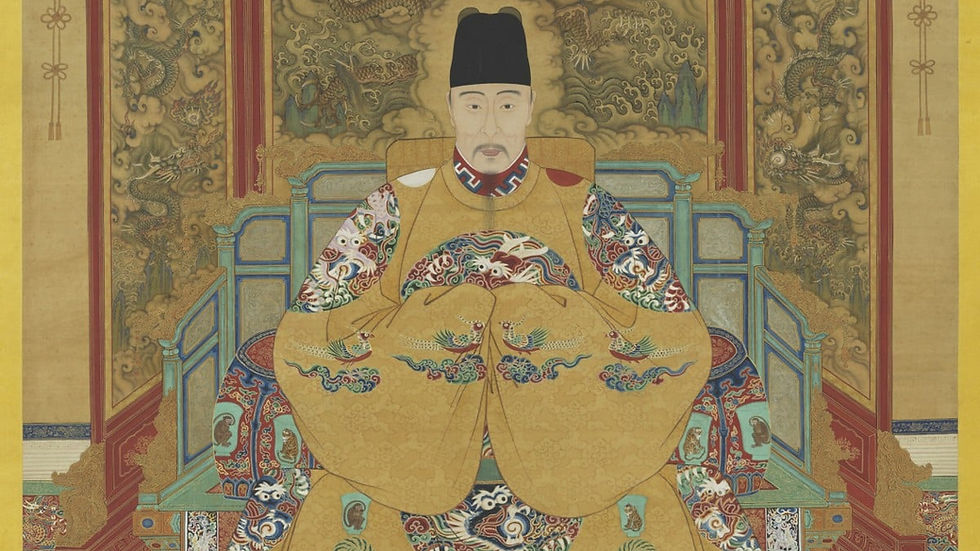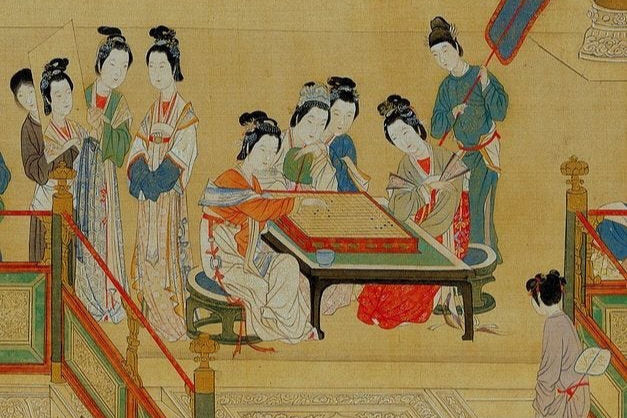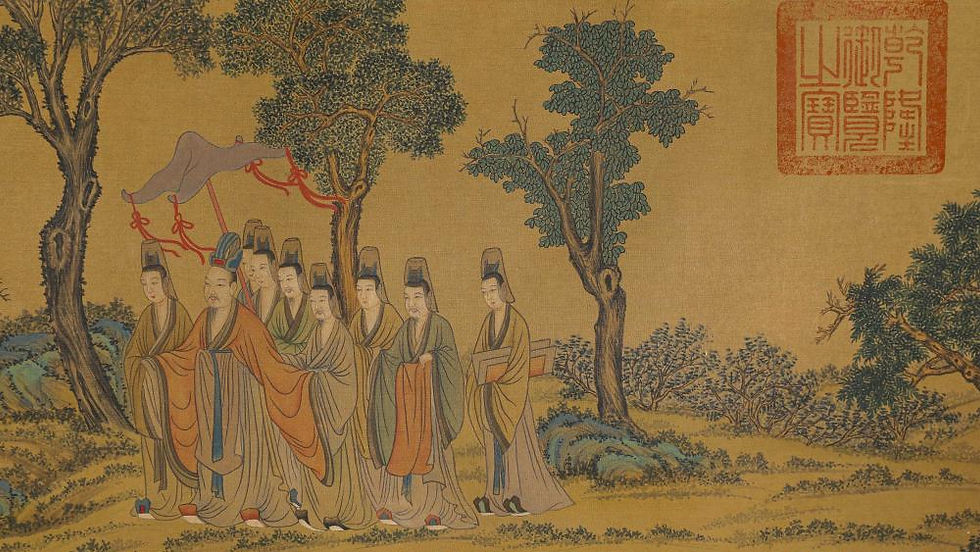The Dark Reign of Jiajing - Death by a Thousand Cuts
- Shannon
- May 28
- 6 min read
Updated: May 30
The Jiajing Emperor, who ruled China’s Ming Dynasty from 1521 to 1567, is often remembered for his sadistic and tyrannical reign marked by cruelty, decadence and obsession with immortality. His relentless pursuit of eternal life led him to engage in dark and brutal practices, one of the most notorious being his bloodlust for a substance called “red lead.” This concoction was allegedly made using the menstrual blood of young virgin girls, which the Taoist Emperor believed held powerful magical properties that could grant him immortality. To produce this vile substance, many girls, often just 13 or 14 years old, were kept in horrific conditions, fed only mulberry leaves and rainwater to keep their blood pure and were subjected to beatings and neglect. If any girl became ill, she was discarded without mercy.

Beyond his cruelty toward the young girls forced to produce the red lead, the Emperor was notorious for violently dominating his concubines, beating them into submission to satisfy his every whim. Known for his strictness and violent outbursts, Jiajing reportedly had as many as 200 palace women beaten to death during his reign. His palace was a place filled with fear, pain and suffering, creating an atmosphere of deep resentment and desperation among those trapped within its walls. The Emperor’s sadism extended far beyond physical abuse. His obsessive consumption of toxic elixirs and complete neglect of state affairs severely weakened the Ming Dynasty during his rule. This dark and oppressive environment eventually reached a breaking point in 1542 with the infamous Renyin Plot, when sixteen palace women, pushed to their limits, staged a desperate attempt to assassinate him. Motivated by a mix of fear, anger and rebellion against the his cruel pursuit of immortality, they attacked him while he was alone in the chambers of his favourite concubine. Unfortunately, their plan failed because they tied the noose incorrectly, leaving the Emperor unconscious but still alive. He was left unable to speak and in a state of shock, an outcome that would have devastating consequences for all involved. After the Renyin Plot was uncovered, his wife, Empress Fang ordered a horrific punishment for the sixteen palace women involved, as well as their families: execution by slow slicing or lingchi. This brutal method of execution was one of the most savage punishments in Chinese history, designed not only to kill but to torture and humiliate over an extended period. Even Consort Duan, the Emperor’s favoured concubine who was innocent of the plot, was executed to eliminate a political rival, highlighting the ruthless and merciless nature of the court’s power struggles. The use of lingchi sent a chilling message about the consequences of defying imperial authority, reinforcing a reign built on fear and cruelty.

Lingchi, also known as the “lingering death” or “death by a thousand cuts,” was practiced in China from around 900 CE until its abolition in 1905. In this brutal form of execution, the condemned was tied to a wooden frame, usually in a public place and portions of their body were methodically cut away over many agonising hours or even days. The term lingchi metaphorically compares the punishment to the slow ascent of a mountain, highlighting the prolonged and torturous nature of the death. Reserved for the most serious crimes such as treason or parricide, lingchi served several cruel purposes. It was a public spectacle meant to maximise humiliation, a prolonged torture that extended the agony of death and a posthumous punishment that prevented the victim’s body from remaining whole, an outcome with profound spiritual consequences in Chinese belief. According to Confucian principles, especially the doctrine of filial piety, the body is a sacred gift from one's parents and must remain intact. Altering or mutilating it is considered deeply unfilial. Lingchi directly violated this moral code by dismembering the body, thus condemning the victim not only to a painful death but also to spiritual fragmentation in the afterlife. Although opium was sometimes administered in later periods to ease pain or prevent fainting, the overarching intent of lingchi was to impose a lingering, degrading death that reinforced the absolute power of the state and underscored the severity of the crime. This combination of physical torment, public humiliation and spiritual condemnation made lingchi one of the most feared and brutal forms of capital punishment in Chinese history.

In the early 16th century, the infamous eunuch Liu Jin, a powerful and notoriously corrupt official serving the Zhengde Emperor, met one of the worst documented examples of Lingchi. In 1510, after amassing excessive influence and effectively controlling the imperial court, Liu Jin was condemned for overstepping his authority and abusing his power. According to legend, Liu Jin endured an excruciating death that lasted three full days, during which he reportedly suffered 3300 individual cuts. This prolonged torment served not only as a physical punishment but also as a public spectacle meant to humiliate him and deter others from similar treachery. Adding a macabre dimension to the event, it was said that the citizens of Beijing paid to buy pieces of Liu Jin’s flesh, which they then consumed with rice wine, an act symbolising both the Emperor’s absolute dominance over his enemies and the populace’s complicity in his downfall. This chilling account underscores the extreme cruelty and theatrical nature of lingchi as both a legal punishment and a cultural ritual in Ming China. Centuries later, Fu Zhuli became the last person officially executed by lingchi before the Chinese government abolished the practice in 1905. His execution marked the end of a brutal, centuries-old tradition. The abolition of lingchi reflected China’s gradual shift toward modernisation and legal reform in the early 20th century, as authorities sought to replace cruel and archaic punishments with more humane justice systems. Fu Zhuli’s death thus stands as a historical milestone, marking the close of one of China’s darkest chapters in judicial punishment and reflecting a nation’s effort to move beyond its brutal past.

Empress Fang’s life came to a violent and premature end in 1547 when she was caught in a palace fire and perished in the flames at just 31 years old. Historical accounts suggest that the Jiajing Emperor deliberately allowed the fire to claim her life, fueled by his resentment toward her role in the execution of his favourite concubine, Consort Duan. This personal grudge highlights the intense factional rivalries and bitter vendettas that permeated the imperial court during his reign. Once a powerful figure who played a key role in suppressing plots against the Emperor, Empress Fang’s influence waned as the court became increasingly unstable and rife with intrigue. The suspicious nature of the fire hints at deliberate political violence or a calculated move to eliminate a rival faction. The Emperor’s cold indifference to her fate reveals the brutal and unforgiving environment of the Ming court under Jiajing’s rule, where even those at the highest echelons faced constant danger. Her death serves as a stark reminder of the precarious and often lethal nature of palace life during one of the most turbulent periods in Chinese history.
The Jiajing Emperor died just 10 years later after ruling the Ming Dynasty for over four decades. His death is widely attributed to the toxic effects of the mercury-laden “elixirs of immortality” that he obsessively consumed in his relentless quest for eternal life. During the 1560s, his health deteriorated significantly. He suffered from insomnia, mood swings and various illnesses, ultimately becoming too weak to issue written orders. He passed away at his palace in the West Park on January 23rd 1567 and was buried in the Yong Mausoleum among the Ming tombs near Beijing. Posthumously, he was honoured with the temple name Shizong and the abbreviated title Emperor Su. Although his long reign provided some measure of stability, his cruel governance and neglect of state affairs severely weakened the dynasty. After his death, the Ming court experienced a brief period of relative peace under his successor, the Longqing Emperor, who sought to restore order and implement reforms. However, the damage caused by Jiajing’s misrule left lasting scars and the Ming Dynasty continued to struggle with internal turmoil and external threats in the years that followed.
万里长城
Thanks for reading The Dark Reign of Jiajing - Death by a Thousand Cuts. Check out more destinations here!

*** All illustrations have been sourced via Wikipedia***







